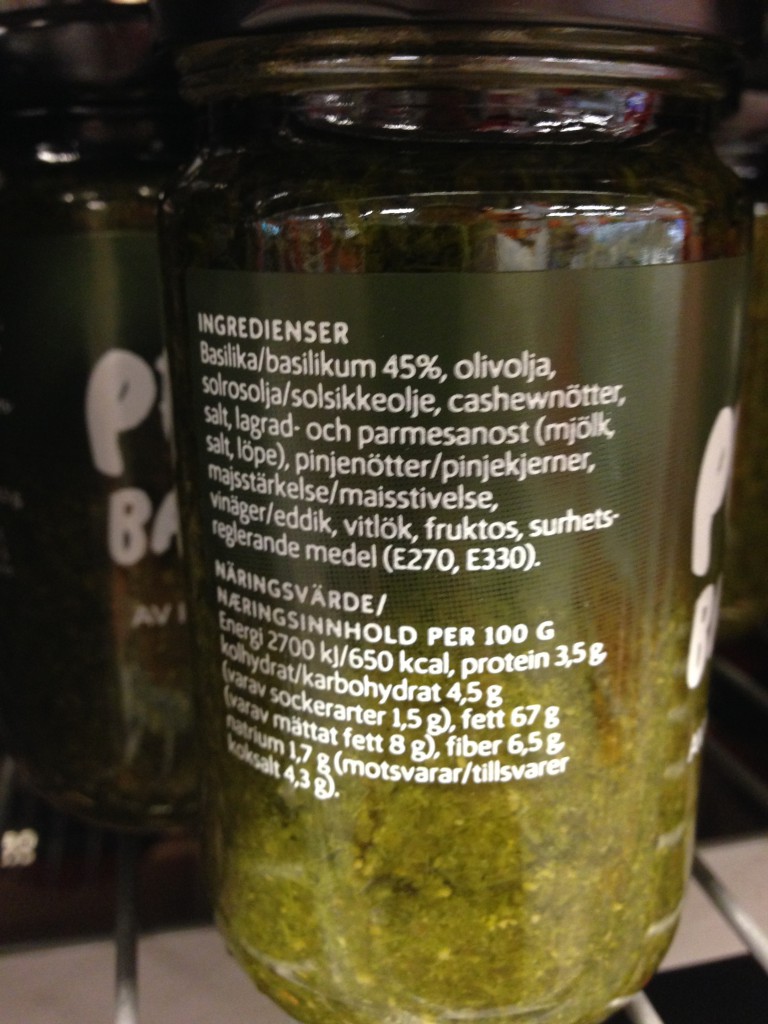Av en ren nyfikenhet så vände jag lite på några burkar när jag var och handlade. Jag handlar aldrig något som är i de där burkarna, men för att roa mig lite så kikade jag på några. Här nedan är en av dem:
I den här burken med pestos så finns det allt möjligt smaskigt. Och för att göra varan ännu mera smarrig så finns det fruktos och två stycken E-nummer. E270=
Lactic acid, is an organic compound belonging to the family of carboxylic acids, it occurs naturally in the blood (in the form of its salts, called lactates) when, during exercise, glycogen is broken down in the muscles. It can be converted back to glycogen in the liver. Known to be difficult for babies to metabolise. Also occurs naturally in sour milk as the result of bacterialogical activity. It is usually obtained commercially by heating and fermenting carbohydrates such as sucrose, molasses, starch, or whey.
As a food additive it increases the antioxidant properties of other substances and can be used to add a bitter taste. In brewing it is used to reduce losses of carbohydrates from germinated barley and for adding to the malt slurry to assist in making a beer of consistent quality.
It is the commonest acidic constituent of fermented milk products such as sour milk, cheese, and buttermilk. Aso used in carbonated drinks, jams, jellies, soft margarine, marmalade, infant milks and cereals, pickled red cabbage, salad dressings, sweets, tartare sauce and many tinned products, such as babyfoods, mackerel, pears, sardines, strawberries and tomatoes.
Vegetarians should be aware that as it is a naturally occurring animal product, it could conceivably be of animal origin.
Så om du är vegetarian så bör du kanske tänka en gång till. Ibland så är det svårt att veta vad man kan äta då E-nummer djungeln är som den är. Och hur många scrollar på sina smartphones då de ska lägga ned en produkt i sin korg?
E330=
The most versatile and widely used organic acid in foodstuffs, citric acid is a colourless, crystalline organic compound, belonging to the family of carboxylic acids.
It is present in practically all plants, and in many animal tissues and fluids, but it is in particularly high concentrations in lemons and other citrus juices and many ripe fruits.
First isolated in 1784 from lemon juice, by the Swedish chemist Carl Wilhelm Scheele, citric acid has been used as a food additive for over 100 years.
It is normally manufactured by fermentation of cane sugar or molasses in the presence of the fungus Aspergillus niger, but it can also be obtained from pineapple by-products and low-grade lemons.
Its use as a food additive is wide and varied – as a synergist to enhance the effectiveness of other antioxidants; as a sharp-tasting flavouring; as a sequestrant in foods it combines with the naturally occurring trace metals to prevent discolouration and in wine production it combines with free iron to prevent the formation of iron-tannin complexes which cause cloudiness; in brewing to reduce excess losses of sugars from the germinated barley; to create an acidic environment to discourage the growth of certain bacteria, yeasts and moulds and in cheese making it produces a faster and more consistent method of producing the necessary acidic environment for the enzyme activity than the traditional souring by lactic acid caused by bacteria.
Because of this versatility it can be found in a wide range of products, including non-alcoholic drinks, bakery products, beer, cheese and processed cheese spreads, cider, biscuits, cake mixes, frozen fish (particularly herrings, shrimps and crab), ice cream, jams, jellies, frozen croquette potatoes and potato waffles, preserves, sorbets, packet soups, sweets, tinned fruits, sauces and vegetables and wine.
Recorded problems are that it can be a local irritant and in large amounts can cause teeth erosion.
However there have been erroneous reports that it is a major cause of cancer. It is thought that this has been brought about by misunderstanding and confusion over the word Krebs.
Citric acid is one of a series of compounds involved in the physiological oxidation of fats, proteins, and carbohydrates to carbon dioxide and water.
This series of chemical reactions, which is central to nearly all metabolic reactions and the source of two-thirds of the food-derived energy in higher organisms was discovered by the German-born British biochemist Sir Hans Adolf Krebs. He actually received the 1953 Nobel Prize for Physiology or Medicine for the discovery, and as well as being known as the tricarboxylic acid cycle (its correct name), it is also known as the citric acid cycle or the Krebs cycle.
Hence, citric acid is fundamental to the Krebs cycle and Krebs is the German word for cancer!
Sen har vi ju fruktos: Det om Fruktos kommer vid 8:a minuter
Jag hoppas att man ser detta i sin helhet!
Det är lätt att bli lurad och jag hoppas att de som blir besvärade av att lära sig om fruktos och andra sockerliknande ämnen inte misströstar. Det går fortfarande att ändra sin livsstil.
